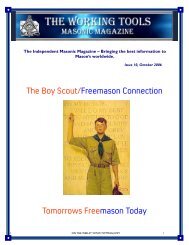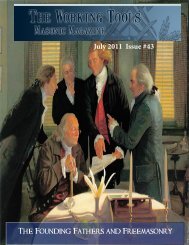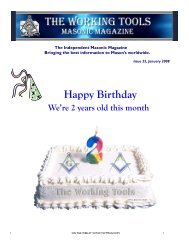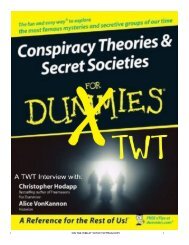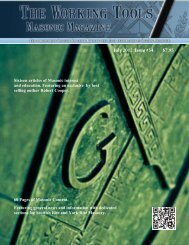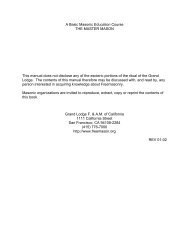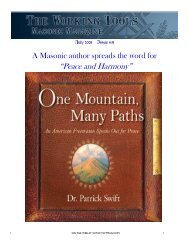The Working Tools Magazine âLightâ Version - Hawthorne-Fortitude ...
The Working Tools Magazine âLightâ Version - Hawthorne-Fortitude ...
The Working Tools Magazine âLightâ Version - Hawthorne-Fortitude ...
You also want an ePaper? Increase the reach of your titles
YUMPU automatically turns print PDFs into web optimized ePapers that Google loves.
<strong>The</strong> Coaches Coach: “Our Masonic Youth”<br />
By Bro. John Nagy<br />
Are we expecting too much from our youthful Brothers?<br />
– Dr. John S. Nagy<br />
Research reflects what our nation’s forefathers knew long<br />
ago: You cannot expect wisdom to be a principle<br />
component of youthful character. <strong>The</strong>y believed this<br />
so strongly that they incorporated this ideal into our<br />
nation’s laws. Ever since that incorporation, citizens must<br />
reach specific age 1 points before they are considered<br />
eligible to hold important governing positions. Examining<br />
these limits in the Light of some of Freemasonry’s<br />
Jurisdictions lowering their age requirements, one<br />
cannot help but ask, “What did our forefathers know about<br />
maturity?”<br />
<strong>The</strong>re should be no doubt in any Masterful Mason’s mind<br />
that Masonic Work transforms good men toward the better.<br />
It does this by engaging their hearts and minds in activities<br />
designed to Work areas of their<br />
brains that promote improved<br />
and mature thinking. <strong>The</strong>se<br />
areas are specific<br />
and Masons who engage in<br />
helping others develop should<br />
take note of these areas early on<br />
to determine this Work’s<br />
effectiveness.<br />
One standard of effectiveness<br />
measurement is the telltale<br />
characteristics of maturity.<br />
Masonic Coaches and Mentors<br />
should well acquaint themselves<br />
with methods that can both develop and ascertain maturity<br />
in those they are asked to assist in Masonic Work. It might<br />
occur to the many<br />
Brothers who Perpend the current state of the Craft that<br />
their failure to acquaint themselves with such Light<br />
weakens the Fraternity and causes our Brothers to focus<br />
attention on Superfluous matters and activities. Reviewing<br />
the division line between Youth and Manhood might be a<br />
good starting point for those interested in being a force for<br />
nurturing change within the Craft.<br />
Youth<br />
It might surprise some people to know that adulthood does<br />
not begin between ages 18 and 21. Yes, this age range is<br />
considered the “legal” age of consent<br />
and the time when those who reach it<br />
can and do take on many “adult”<br />
activities and responsibilities. It is also<br />
around the time when a person is<br />
judged and held accountable as an<br />
adult. This age range is also long past<br />
when participation in<br />
biological reproduction can and<br />
sometimes does occur for some of us.<br />
Benchmarks set up by modern society as predetermined<br />
transition points between Youth and Adulthood are not<br />
however when biological adulthood begins. Biological<br />
adulthood in humans occurs several years later, and in<br />
some cases much later, if at all. 2 Human Biological<br />
Adulthood is dependent upon the “coming to fruition” of a<br />
specific portion of the brain called, “the PreFrontal<br />
Cortex”.<br />
Pre-Manhood<br />
According to researchers, the Pre-<br />
Frontal Cortex (PFC) is the<br />
portion of the human brain<br />
responsible for differentiating<br />
Youth and Adulthood. <strong>The</strong> PFC is<br />
proportionally larger in humans<br />
than all other animals. It has also<br />
grown proportionally bigger in<br />
relation to other<br />
portions of the human brain over<br />
the time humans have purported to<br />
have existed on earth. In humans, the PFC continues to<br />
grow into the mid twenties. This growth though is in size<br />
only and other important PFC interconnections continue to<br />
change and grow long after this point.<br />
This is well indicated by further important character<br />
development taking place long after the time<br />
that the PFC reaches its full size.<br />
Coaches and Mentors should know that Character is a very<br />
good indicator of overall and specific<br />
maturity. A lack of maturity indicates further PFC<br />
development is necessary. <strong>The</strong><br />
(Continued on page 20)<br />
19 www.twtmag.com





